Toyota Motor Corporation: Operations Management, Design, and Quality
VerifiedAdded on 2023/06/10
|13
|3479
|70
Report
AI Summary
This report provides a comprehensive overview of Toyota Motor Corporation's operations management. It begins with an introduction to operations management and its importance, followed by a brief history of Toyota. The core of the report delves into Toyota's operations management strategies, including the Just-in-Time system and lean manufacturing principles. It examines the design of goods and services, highlighting the processes involved in car design, from concept to mock-up and the decision hall. The report also analyzes Toyota's quality management practices, emphasizing the Toyota Production System (TPS) and the measures taken to ensure quality and durability. Furthermore, it discusses the features of Toyota's modern engines and transmissions, and the company's commitment to continuous improvement and innovation through the Toyota Global Architecture (TNGA) and hybrid systems. The report concludes by emphasizing Toyota's lean manufacturing approach, focusing on eliminating waste and maximizing efficiency to meet customer needs. The report emphasizes how Toyota's operational strategies have contributed to its global success.
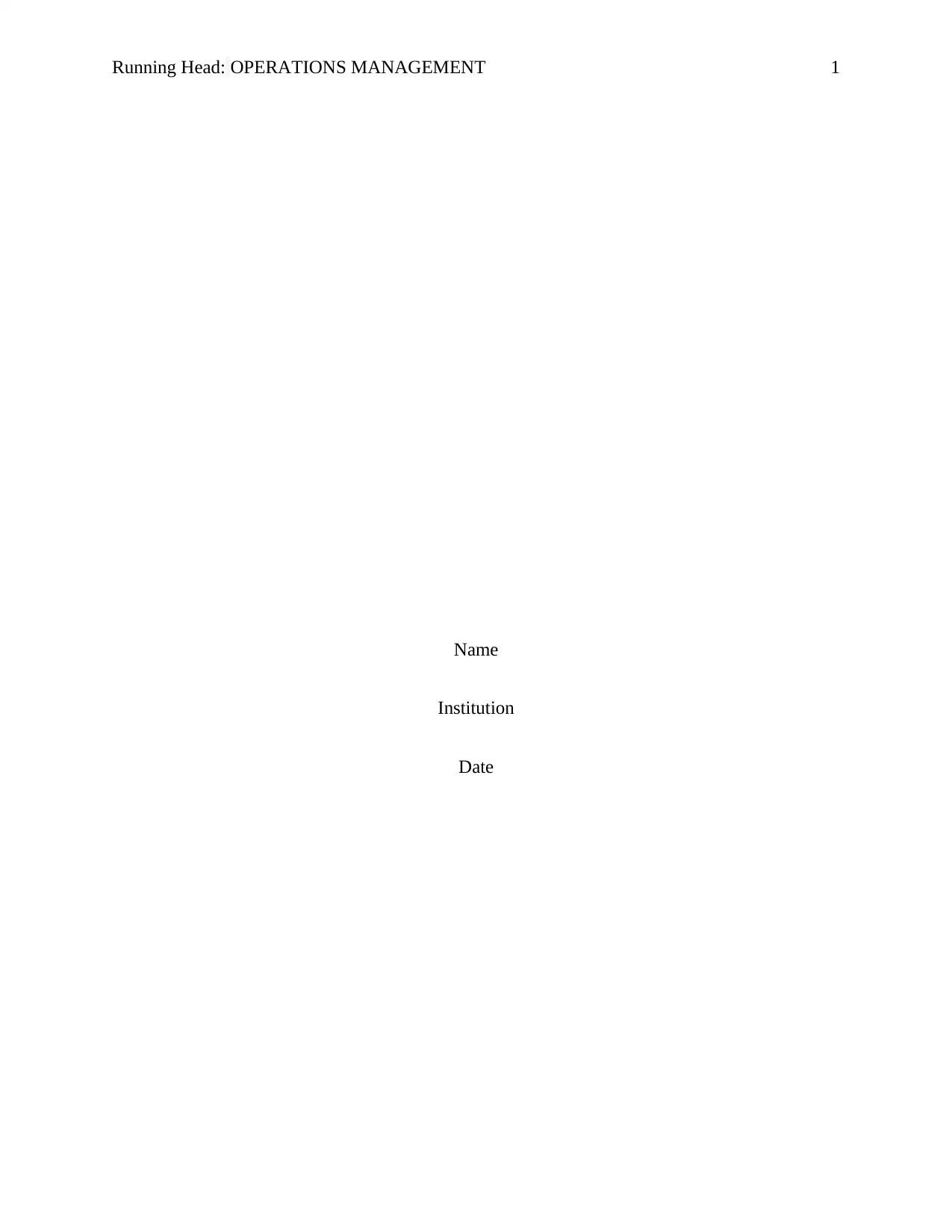
Running Head: OPERATIONS MANAGEMENT 1
Name
Institution
Date
Name
Institution
Date
Paraphrase This Document
Need a fresh take? Get an instant paraphrase of this document with our AI Paraphraser
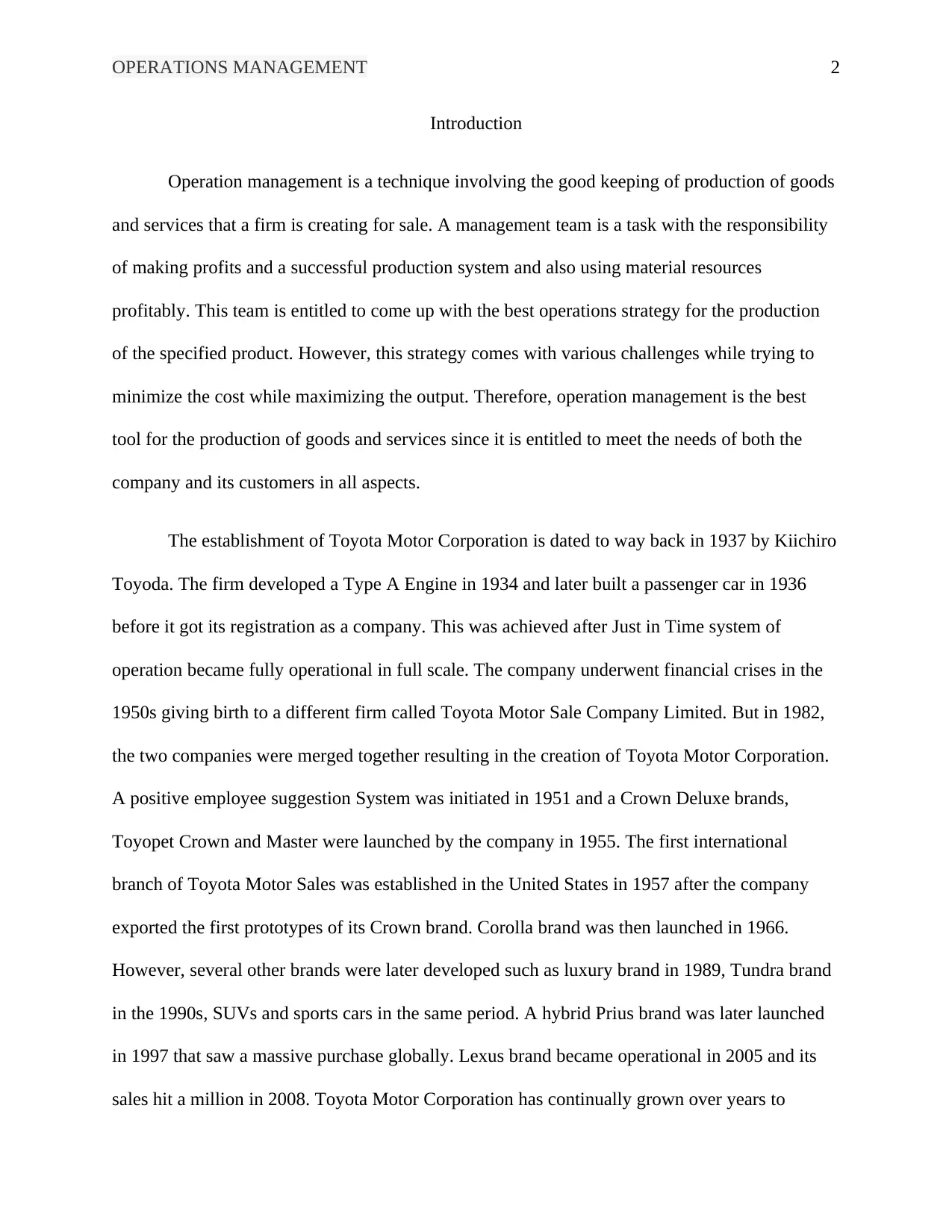
OPERATIONS MANAGEMENT 2
Introduction
Operation management is a technique involving the good keeping of production of goods
and services that a firm is creating for sale. A management team is a task with the responsibility
of making profits and a successful production system and also using material resources
profitably. This team is entitled to come up with the best operations strategy for the production
of the specified product. However, this strategy comes with various challenges while trying to
minimize the cost while maximizing the output. Therefore, operation management is the best
tool for the production of goods and services since it is entitled to meet the needs of both the
company and its customers in all aspects.
The establishment of Toyota Motor Corporation is dated to way back in 1937 by Kiichiro
Toyoda. The firm developed a Type A Engine in 1934 and later built a passenger car in 1936
before it got its registration as a company. This was achieved after Just in Time system of
operation became fully operational in full scale. The company underwent financial crises in the
1950s giving birth to a different firm called Toyota Motor Sale Company Limited. But in 1982,
the two companies were merged together resulting in the creation of Toyota Motor Corporation.
A positive employee suggestion System was initiated in 1951 and a Crown Deluxe brands,
Toyopet Crown and Master were launched by the company in 1955. The first international
branch of Toyota Motor Sales was established in the United States in 1957 after the company
exported the first prototypes of its Crown brand. Corolla brand was then launched in 1966.
However, several other brands were later developed such as luxury brand in 1989, Tundra brand
in the 1990s, SUVs and sports cars in the same period. A hybrid Prius brand was later launched
in 1997 that saw a massive purchase globally. Lexus brand became operational in 2005 and its
sales hit a million in 2008. Toyota Motor Corporation has continually grown over years to
Introduction
Operation management is a technique involving the good keeping of production of goods
and services that a firm is creating for sale. A management team is a task with the responsibility
of making profits and a successful production system and also using material resources
profitably. This team is entitled to come up with the best operations strategy for the production
of the specified product. However, this strategy comes with various challenges while trying to
minimize the cost while maximizing the output. Therefore, operation management is the best
tool for the production of goods and services since it is entitled to meet the needs of both the
company and its customers in all aspects.
The establishment of Toyota Motor Corporation is dated to way back in 1937 by Kiichiro
Toyoda. The firm developed a Type A Engine in 1934 and later built a passenger car in 1936
before it got its registration as a company. This was achieved after Just in Time system of
operation became fully operational in full scale. The company underwent financial crises in the
1950s giving birth to a different firm called Toyota Motor Sale Company Limited. But in 1982,
the two companies were merged together resulting in the creation of Toyota Motor Corporation.
A positive employee suggestion System was initiated in 1951 and a Crown Deluxe brands,
Toyopet Crown and Master were launched by the company in 1955. The first international
branch of Toyota Motor Sales was established in the United States in 1957 after the company
exported the first prototypes of its Crown brand. Corolla brand was then launched in 1966.
However, several other brands were later developed such as luxury brand in 1989, Tundra brand
in the 1990s, SUVs and sports cars in the same period. A hybrid Prius brand was later launched
in 1997 that saw a massive purchase globally. Lexus brand became operational in 2005 and its
sales hit a million in 2008. Toyota Motor Corporation has continually grown over years to
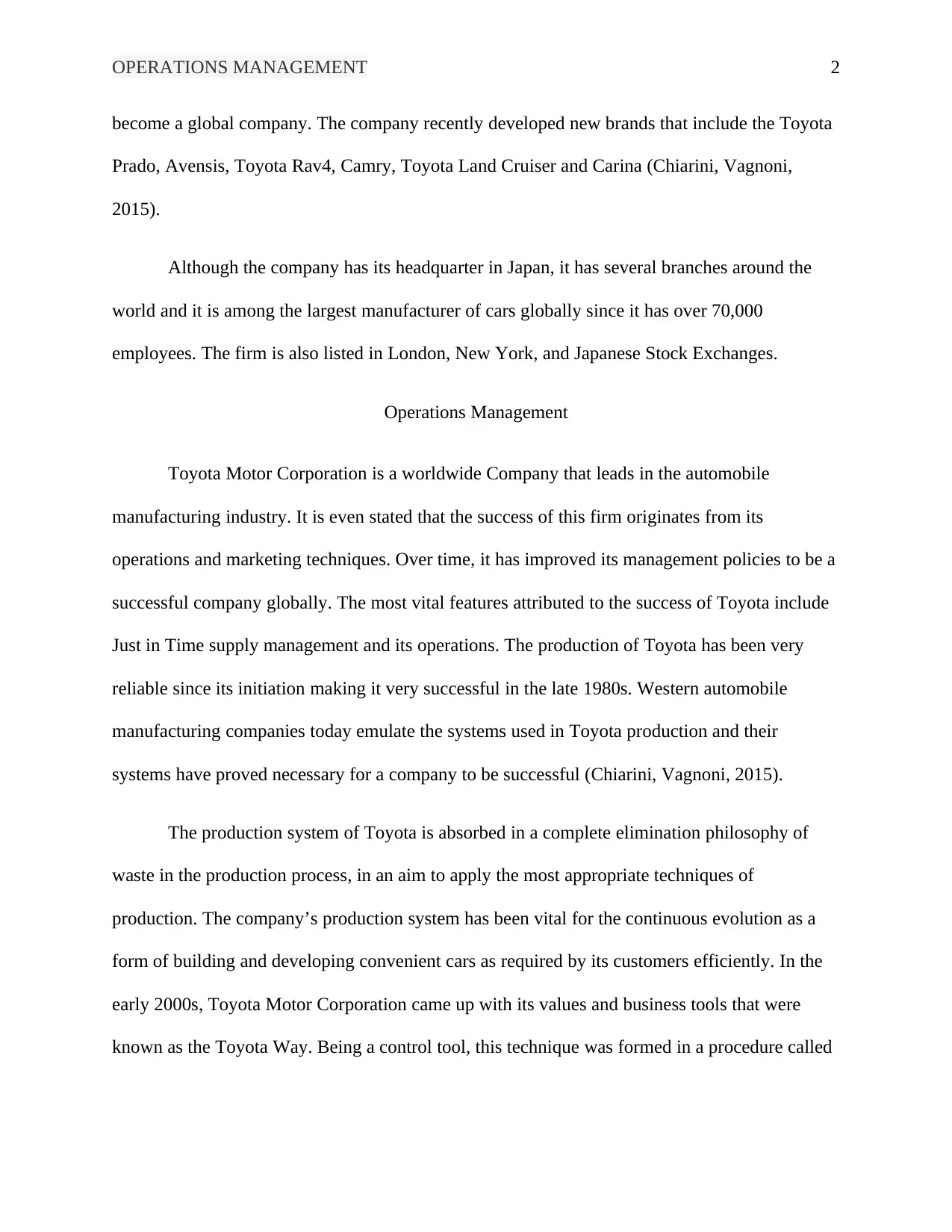
OPERATIONS MANAGEMENT 2
become a global company. The company recently developed new brands that include the Toyota
Prado, Avensis, Toyota Rav4, Camry, Toyota Land Cruiser and Carina (Chiarini, Vagnoni,
2015).
Although the company has its headquarter in Japan, it has several branches around the
world and it is among the largest manufacturer of cars globally since it has over 70,000
employees. The firm is also listed in London, New York, and Japanese Stock Exchanges.
Operations Management
Toyota Motor Corporation is a worldwide Company that leads in the automobile
manufacturing industry. It is even stated that the success of this firm originates from its
operations and marketing techniques. Over time, it has improved its management policies to be a
successful company globally. The most vital features attributed to the success of Toyota include
Just in Time supply management and its operations. The production of Toyota has been very
reliable since its initiation making it very successful in the late 1980s. Western automobile
manufacturing companies today emulate the systems used in Toyota production and their
systems have proved necessary for a company to be successful (Chiarini, Vagnoni, 2015).
The production system of Toyota is absorbed in a complete elimination philosophy of
waste in the production process, in an aim to apply the most appropriate techniques of
production. The company’s production system has been vital for the continuous evolution as a
form of building and developing convenient cars as required by its customers efficiently. In the
early 2000s, Toyota Motor Corporation came up with its values and business tools that were
known as the Toyota Way. Being a control tool, this technique was formed in a procedure called
become a global company. The company recently developed new brands that include the Toyota
Prado, Avensis, Toyota Rav4, Camry, Toyota Land Cruiser and Carina (Chiarini, Vagnoni,
2015).
Although the company has its headquarter in Japan, it has several branches around the
world and it is among the largest manufacturer of cars globally since it has over 70,000
employees. The firm is also listed in London, New York, and Japanese Stock Exchanges.
Operations Management
Toyota Motor Corporation is a worldwide Company that leads in the automobile
manufacturing industry. It is even stated that the success of this firm originates from its
operations and marketing techniques. Over time, it has improved its management policies to be a
successful company globally. The most vital features attributed to the success of Toyota include
Just in Time supply management and its operations. The production of Toyota has been very
reliable since its initiation making it very successful in the late 1980s. Western automobile
manufacturing companies today emulate the systems used in Toyota production and their
systems have proved necessary for a company to be successful (Chiarini, Vagnoni, 2015).
The production system of Toyota is absorbed in a complete elimination philosophy of
waste in the production process, in an aim to apply the most appropriate techniques of
production. The company’s production system has been vital for the continuous evolution as a
form of building and developing convenient cars as required by its customers efficiently. In the
early 2000s, Toyota Motor Corporation came up with its values and business tools that were
known as the Toyota Way. Being a control tool, this technique was formed in a procedure called
⊘ This is a preview!⊘
Do you want full access?
Subscribe today to unlock all pages.

Trusted by 1+ million students worldwide
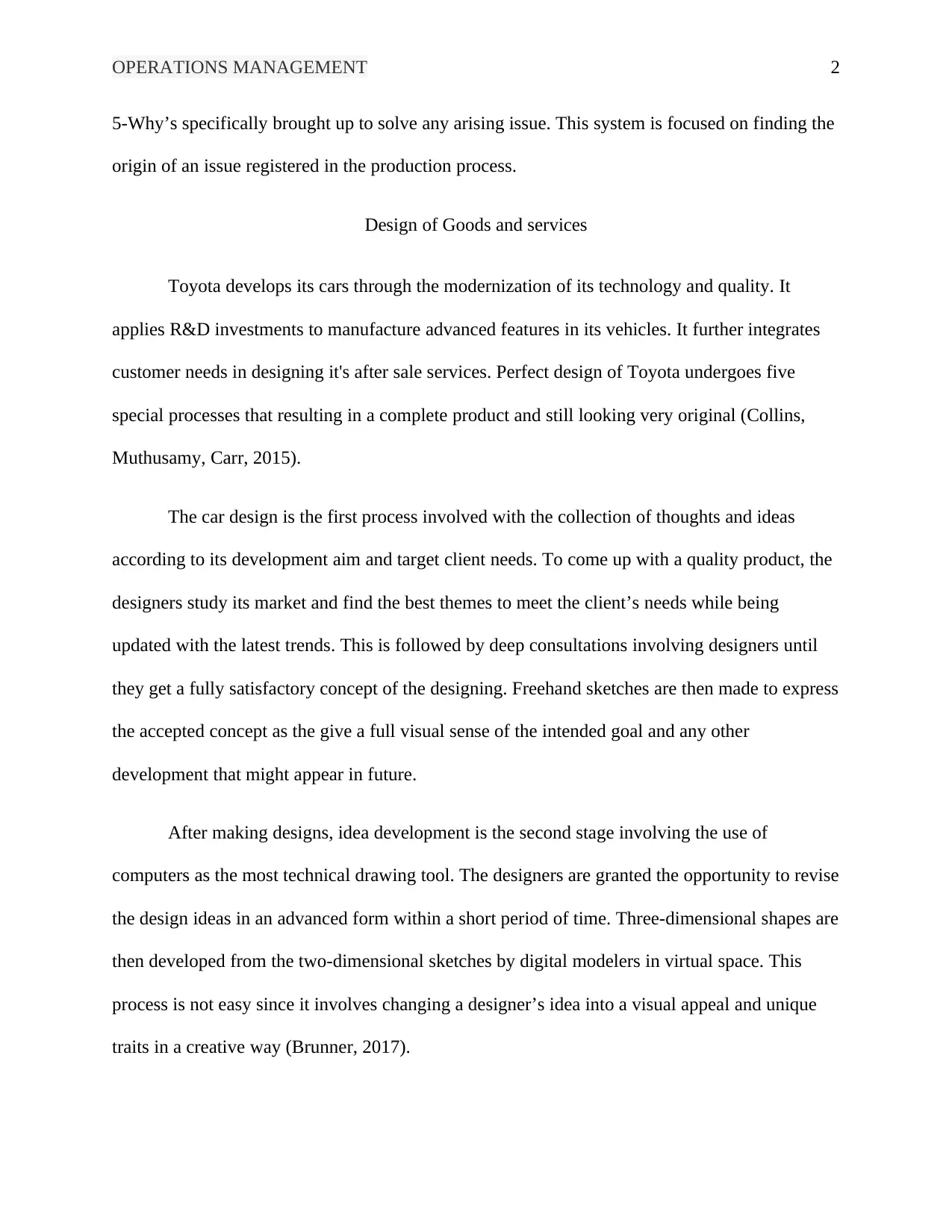
OPERATIONS MANAGEMENT 2
5-Why’s specifically brought up to solve any arising issue. This system is focused on finding the
origin of an issue registered in the production process.
Design of Goods and services
Toyota develops its cars through the modernization of its technology and quality. It
applies R&D investments to manufacture advanced features in its vehicles. It further integrates
customer needs in designing it's after sale services. Perfect design of Toyota undergoes five
special processes that resulting in a complete product and still looking very original (Collins,
Muthusamy, Carr, 2015).
The car design is the first process involved with the collection of thoughts and ideas
according to its development aim and target client needs. To come up with a quality product, the
designers study its market and find the best themes to meet the client’s needs while being
updated with the latest trends. This is followed by deep consultations involving designers until
they get a fully satisfactory concept of the designing. Freehand sketches are then made to express
the accepted concept as the give a full visual sense of the intended goal and any other
development that might appear in future.
After making designs, idea development is the second stage involving the use of
computers as the most technical drawing tool. The designers are granted the opportunity to revise
the design ideas in an advanced form within a short period of time. Three-dimensional shapes are
then developed from the two-dimensional sketches by digital modelers in virtual space. This
process is not easy since it involves changing a designer’s idea into a visual appeal and unique
traits in a creative way (Brunner, 2017).
5-Why’s specifically brought up to solve any arising issue. This system is focused on finding the
origin of an issue registered in the production process.
Design of Goods and services
Toyota develops its cars through the modernization of its technology and quality. It
applies R&D investments to manufacture advanced features in its vehicles. It further integrates
customer needs in designing it's after sale services. Perfect design of Toyota undergoes five
special processes that resulting in a complete product and still looking very original (Collins,
Muthusamy, Carr, 2015).
The car design is the first process involved with the collection of thoughts and ideas
according to its development aim and target client needs. To come up with a quality product, the
designers study its market and find the best themes to meet the client’s needs while being
updated with the latest trends. This is followed by deep consultations involving designers until
they get a fully satisfactory concept of the designing. Freehand sketches are then made to express
the accepted concept as the give a full visual sense of the intended goal and any other
development that might appear in future.
After making designs, idea development is the second stage involving the use of
computers as the most technical drawing tool. The designers are granted the opportunity to revise
the design ideas in an advanced form within a short period of time. Three-dimensional shapes are
then developed from the two-dimensional sketches by digital modelers in virtual space. This
process is not easy since it involves changing a designer’s idea into a visual appeal and unique
traits in a creative way (Brunner, 2017).
Paraphrase This Document
Need a fresh take? Get an instant paraphrase of this document with our AI Paraphraser
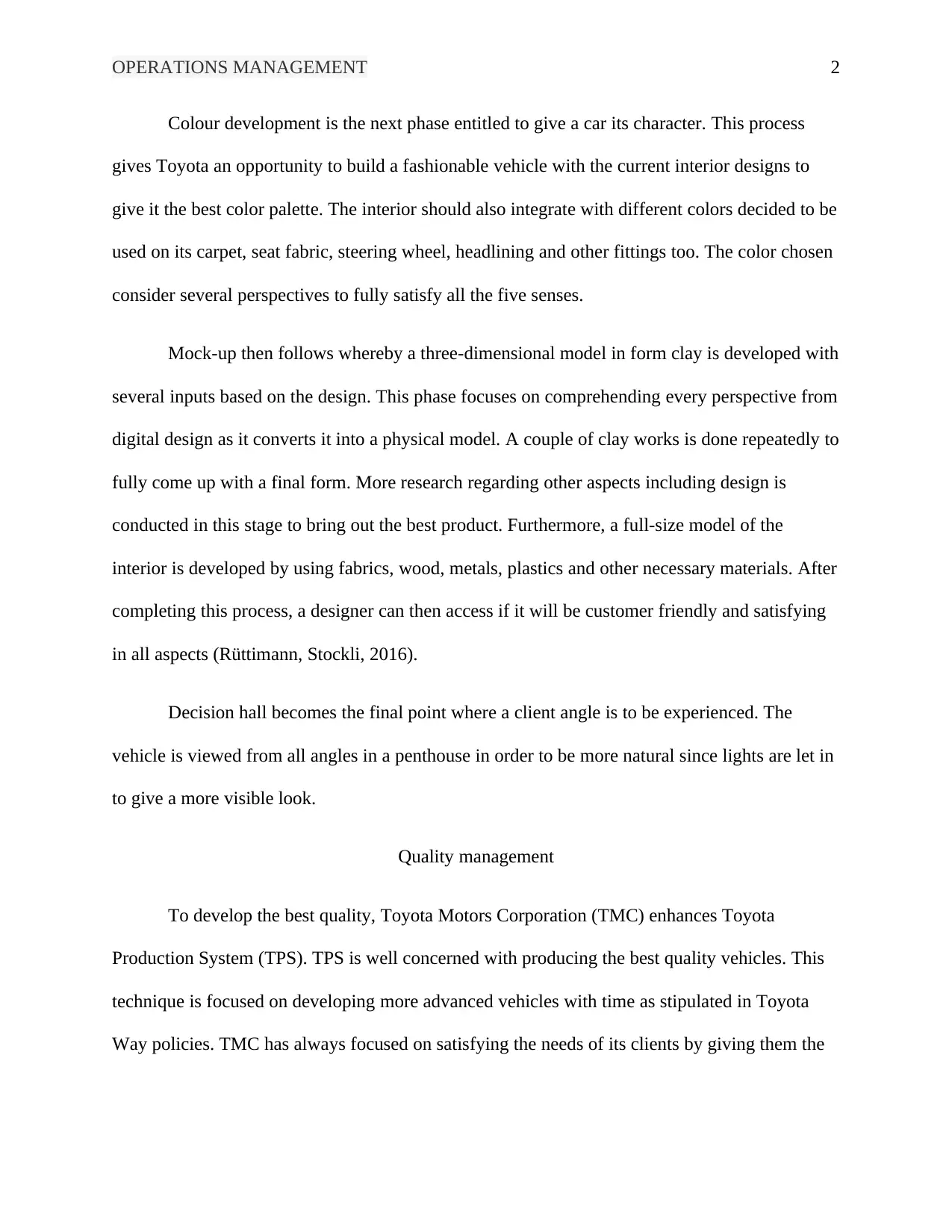
OPERATIONS MANAGEMENT 2
Colour development is the next phase entitled to give a car its character. This process
gives Toyota an opportunity to build a fashionable vehicle with the current interior designs to
give it the best color palette. The interior should also integrate with different colors decided to be
used on its carpet, seat fabric, steering wheel, headlining and other fittings too. The color chosen
consider several perspectives to fully satisfy all the five senses.
Mock-up then follows whereby a three-dimensional model in form clay is developed with
several inputs based on the design. This phase focuses on comprehending every perspective from
digital design as it converts it into a physical model. A couple of clay works is done repeatedly to
fully come up with a final form. More research regarding other aspects including design is
conducted in this stage to bring out the best product. Furthermore, a full-size model of the
interior is developed by using fabrics, wood, metals, plastics and other necessary materials. After
completing this process, a designer can then access if it will be customer friendly and satisfying
in all aspects (Rüttimann, Stockli, 2016).
Decision hall becomes the final point where a client angle is to be experienced. The
vehicle is viewed from all angles in a penthouse in order to be more natural since lights are let in
to give a more visible look.
Quality management
To develop the best quality, Toyota Motors Corporation (TMC) enhances Toyota
Production System (TPS). TPS is well concerned with producing the best quality vehicles. This
technique is focused on developing more advanced vehicles with time as stipulated in Toyota
Way policies. TMC has always focused on satisfying the needs of its clients by giving them the
Colour development is the next phase entitled to give a car its character. This process
gives Toyota an opportunity to build a fashionable vehicle with the current interior designs to
give it the best color palette. The interior should also integrate with different colors decided to be
used on its carpet, seat fabric, steering wheel, headlining and other fittings too. The color chosen
consider several perspectives to fully satisfy all the five senses.
Mock-up then follows whereby a three-dimensional model in form clay is developed with
several inputs based on the design. This phase focuses on comprehending every perspective from
digital design as it converts it into a physical model. A couple of clay works is done repeatedly to
fully come up with a final form. More research regarding other aspects including design is
conducted in this stage to bring out the best product. Furthermore, a full-size model of the
interior is developed by using fabrics, wood, metals, plastics and other necessary materials. After
completing this process, a designer can then access if it will be customer friendly and satisfying
in all aspects (Rüttimann, Stockli, 2016).
Decision hall becomes the final point where a client angle is to be experienced. The
vehicle is viewed from all angles in a penthouse in order to be more natural since lights are let in
to give a more visible look.
Quality management
To develop the best quality, Toyota Motors Corporation (TMC) enhances Toyota
Production System (TPS). TPS is well concerned with producing the best quality vehicles. This
technique is focused on developing more advanced vehicles with time as stipulated in Toyota
Way policies. TMC has always focused on satisfying the needs of its clients by giving them the
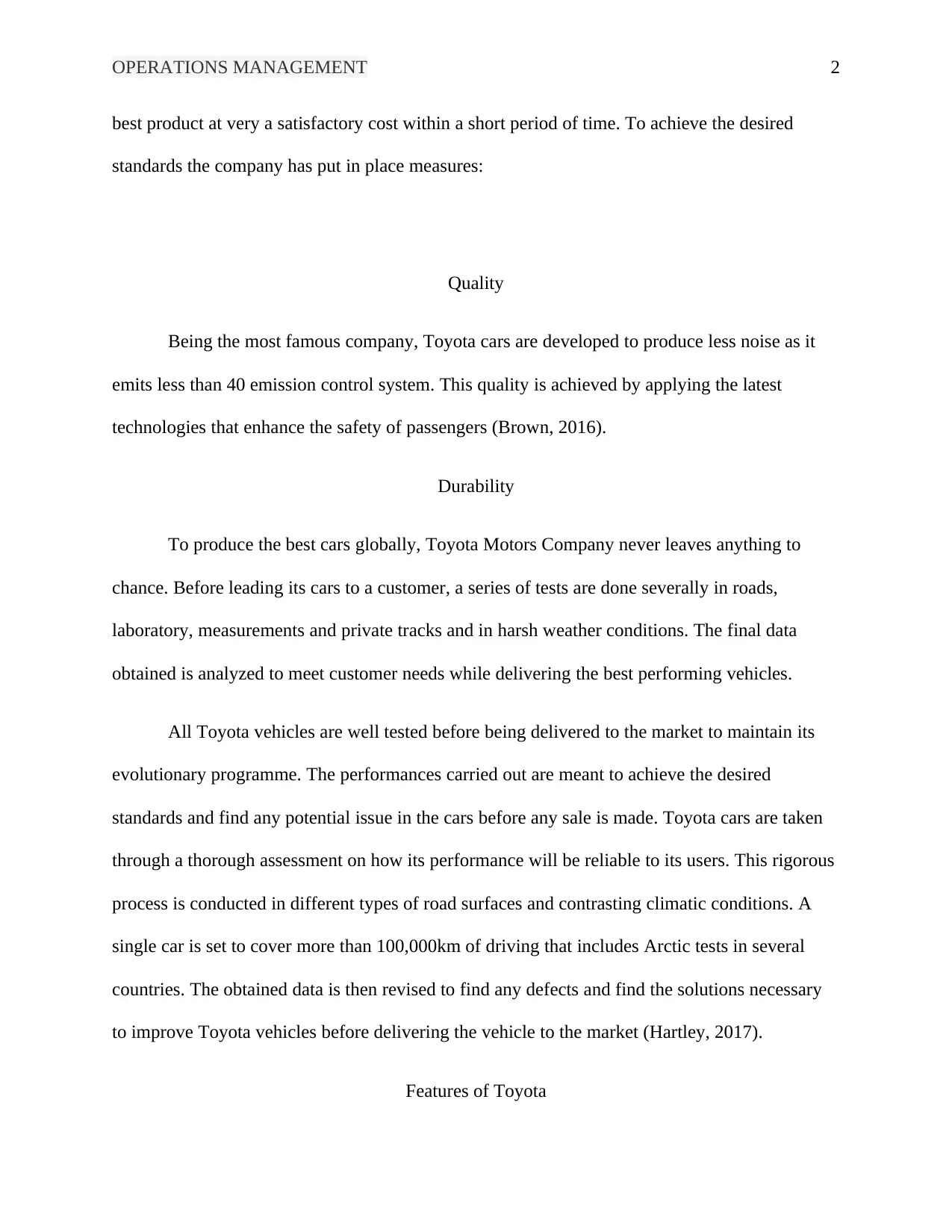
OPERATIONS MANAGEMENT 2
best product at very a satisfactory cost within a short period of time. To achieve the desired
standards the company has put in place measures:
Quality
Being the most famous company, Toyota cars are developed to produce less noise as it
emits less than 40 emission control system. This quality is achieved by applying the latest
technologies that enhance the safety of passengers (Brown, 2016).
Durability
To produce the best cars globally, Toyota Motors Company never leaves anything to
chance. Before leading its cars to a customer, a series of tests are done severally in roads,
laboratory, measurements and private tracks and in harsh weather conditions. The final data
obtained is analyzed to meet customer needs while delivering the best performing vehicles.
All Toyota vehicles are well tested before being delivered to the market to maintain its
evolutionary programme. The performances carried out are meant to achieve the desired
standards and find any potential issue in the cars before any sale is made. Toyota cars are taken
through a thorough assessment on how its performance will be reliable to its users. This rigorous
process is conducted in different types of road surfaces and contrasting climatic conditions. A
single car is set to cover more than 100,000km of driving that includes Arctic tests in several
countries. The obtained data is then revised to find any defects and find the solutions necessary
to improve Toyota vehicles before delivering the vehicle to the market (Hartley, 2017).
Features of Toyota
best product at very a satisfactory cost within a short period of time. To achieve the desired
standards the company has put in place measures:
Quality
Being the most famous company, Toyota cars are developed to produce less noise as it
emits less than 40 emission control system. This quality is achieved by applying the latest
technologies that enhance the safety of passengers (Brown, 2016).
Durability
To produce the best cars globally, Toyota Motors Company never leaves anything to
chance. Before leading its cars to a customer, a series of tests are done severally in roads,
laboratory, measurements and private tracks and in harsh weather conditions. The final data
obtained is analyzed to meet customer needs while delivering the best performing vehicles.
All Toyota vehicles are well tested before being delivered to the market to maintain its
evolutionary programme. The performances carried out are meant to achieve the desired
standards and find any potential issue in the cars before any sale is made. Toyota cars are taken
through a thorough assessment on how its performance will be reliable to its users. This rigorous
process is conducted in different types of road surfaces and contrasting climatic conditions. A
single car is set to cover more than 100,000km of driving that includes Arctic tests in several
countries. The obtained data is then revised to find any defects and find the solutions necessary
to improve Toyota vehicles before delivering the vehicle to the market (Hartley, 2017).
Features of Toyota
⊘ This is a preview!⊘
Do you want full access?
Subscribe today to unlock all pages.

Trusted by 1+ million students worldwide
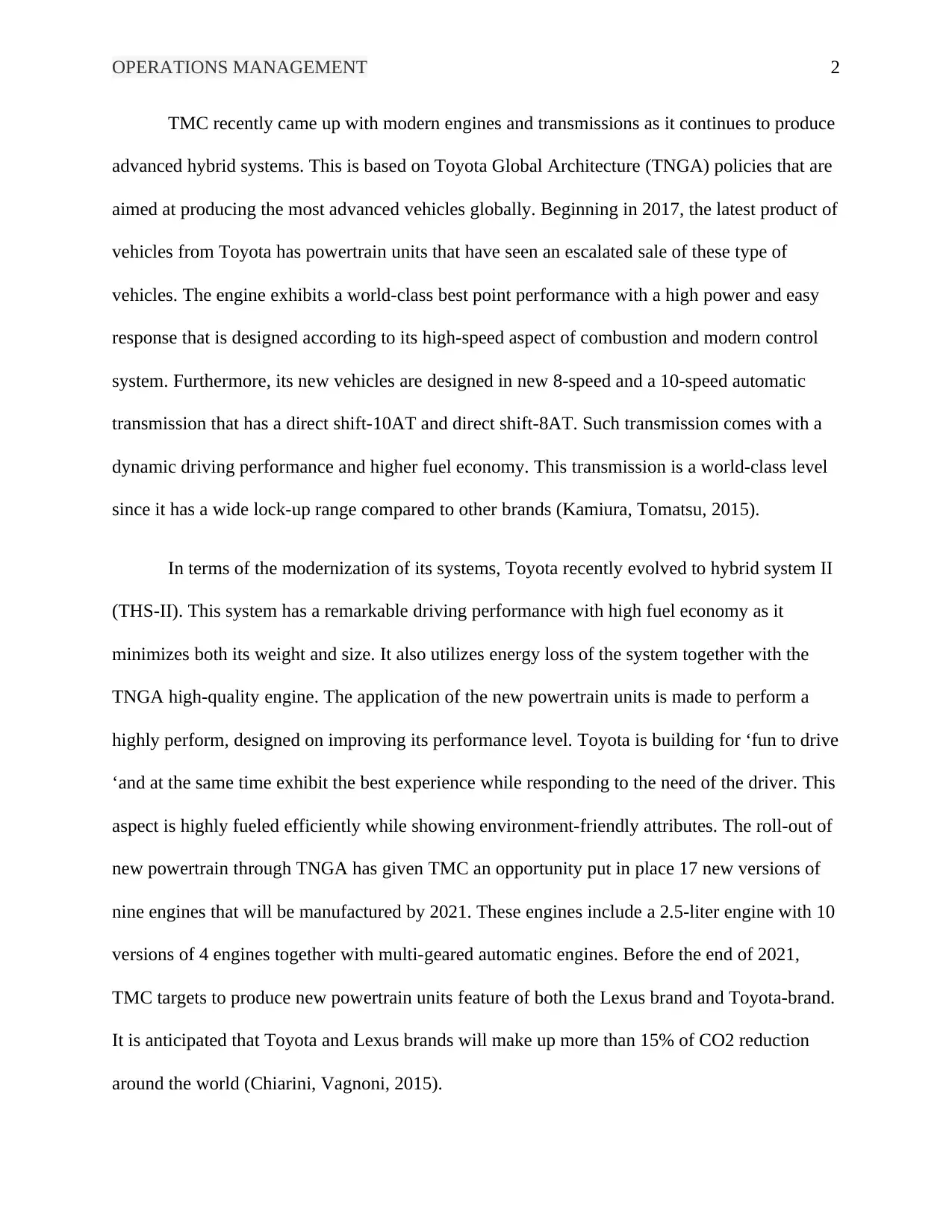
OPERATIONS MANAGEMENT 2
TMC recently came up with modern engines and transmissions as it continues to produce
advanced hybrid systems. This is based on Toyota Global Architecture (TNGA) policies that are
aimed at producing the most advanced vehicles globally. Beginning in 2017, the latest product of
vehicles from Toyota has powertrain units that have seen an escalated sale of these type of
vehicles. The engine exhibits a world-class best point performance with a high power and easy
response that is designed according to its high-speed aspect of combustion and modern control
system. Furthermore, its new vehicles are designed in new 8-speed and a 10-speed automatic
transmission that has a direct shift-10AT and direct shift-8AT. Such transmission comes with a
dynamic driving performance and higher fuel economy. This transmission is a world-class level
since it has a wide lock-up range compared to other brands (Kamiura, Tomatsu, 2015).
In terms of the modernization of its systems, Toyota recently evolved to hybrid system II
(THS-II). This system has a remarkable driving performance with high fuel economy as it
minimizes both its weight and size. It also utilizes energy loss of the system together with the
TNGA high-quality engine. The application of the new powertrain units is made to perform a
highly perform, designed on improving its performance level. Toyota is building for ‘fun to drive
‘and at the same time exhibit the best experience while responding to the need of the driver. This
aspect is highly fueled efficiently while showing environment-friendly attributes. The roll-out of
new powertrain through TNGA has given TMC an opportunity put in place 17 new versions of
nine engines that will be manufactured by 2021. These engines include a 2.5-liter engine with 10
versions of 4 engines together with multi-geared automatic engines. Before the end of 2021,
TMC targets to produce new powertrain units feature of both the Lexus brand and Toyota-brand.
It is anticipated that Toyota and Lexus brands will make up more than 15% of CO2 reduction
around the world (Chiarini, Vagnoni, 2015).
TMC recently came up with modern engines and transmissions as it continues to produce
advanced hybrid systems. This is based on Toyota Global Architecture (TNGA) policies that are
aimed at producing the most advanced vehicles globally. Beginning in 2017, the latest product of
vehicles from Toyota has powertrain units that have seen an escalated sale of these type of
vehicles. The engine exhibits a world-class best point performance with a high power and easy
response that is designed according to its high-speed aspect of combustion and modern control
system. Furthermore, its new vehicles are designed in new 8-speed and a 10-speed automatic
transmission that has a direct shift-10AT and direct shift-8AT. Such transmission comes with a
dynamic driving performance and higher fuel economy. This transmission is a world-class level
since it has a wide lock-up range compared to other brands (Kamiura, Tomatsu, 2015).
In terms of the modernization of its systems, Toyota recently evolved to hybrid system II
(THS-II). This system has a remarkable driving performance with high fuel economy as it
minimizes both its weight and size. It also utilizes energy loss of the system together with the
TNGA high-quality engine. The application of the new powertrain units is made to perform a
highly perform, designed on improving its performance level. Toyota is building for ‘fun to drive
‘and at the same time exhibit the best experience while responding to the need of the driver. This
aspect is highly fueled efficiently while showing environment-friendly attributes. The roll-out of
new powertrain through TNGA has given TMC an opportunity put in place 17 new versions of
nine engines that will be manufactured by 2021. These engines include a 2.5-liter engine with 10
versions of 4 engines together with multi-geared automatic engines. Before the end of 2021,
TMC targets to produce new powertrain units feature of both the Lexus brand and Toyota-brand.
It is anticipated that Toyota and Lexus brands will make up more than 15% of CO2 reduction
around the world (Chiarini, Vagnoni, 2015).
Paraphrase This Document
Need a fresh take? Get an instant paraphrase of this document with our AI Paraphraser
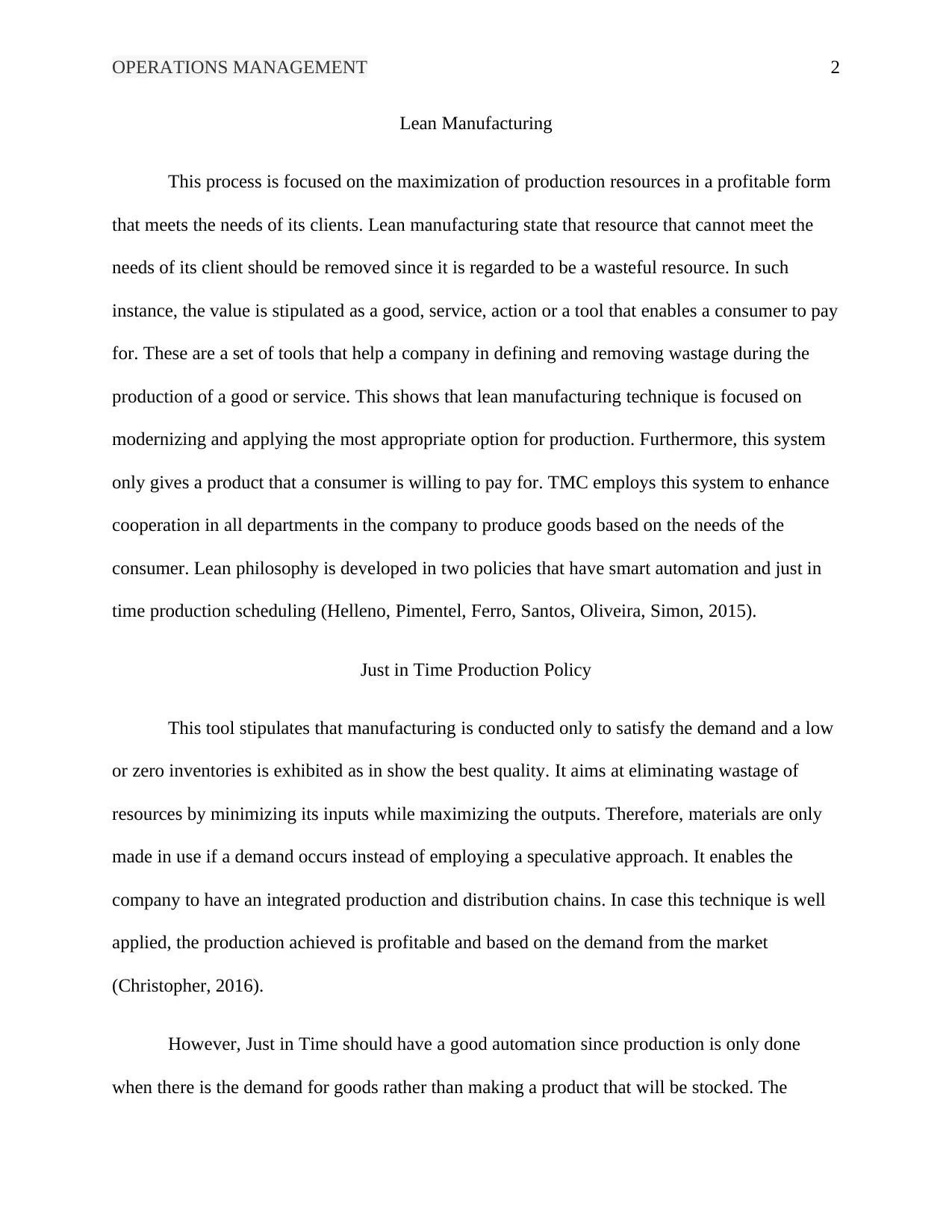
OPERATIONS MANAGEMENT 2
Lean Manufacturing
This process is focused on the maximization of production resources in a profitable form
that meets the needs of its clients. Lean manufacturing state that resource that cannot meet the
needs of its client should be removed since it is regarded to be a wasteful resource. In such
instance, the value is stipulated as a good, service, action or a tool that enables a consumer to pay
for. These are a set of tools that help a company in defining and removing wastage during the
production of a good or service. This shows that lean manufacturing technique is focused on
modernizing and applying the most appropriate option for production. Furthermore, this system
only gives a product that a consumer is willing to pay for. TMC employs this system to enhance
cooperation in all departments in the company to produce goods based on the needs of the
consumer. Lean philosophy is developed in two policies that have smart automation and just in
time production scheduling (Helleno, Pimentel, Ferro, Santos, Oliveira, Simon, 2015).
Just in Time Production Policy
This tool stipulates that manufacturing is conducted only to satisfy the demand and a low
or zero inventories is exhibited as in show the best quality. It aims at eliminating wastage of
resources by minimizing its inputs while maximizing the outputs. Therefore, materials are only
made in use if a demand occurs instead of employing a speculative approach. It enables the
company to have an integrated production and distribution chains. In case this technique is well
applied, the production achieved is profitable and based on the demand from the market
(Christopher, 2016).
However, Just in Time should have a good automation since production is only done
when there is the demand for goods rather than making a product that will be stocked. The
Lean Manufacturing
This process is focused on the maximization of production resources in a profitable form
that meets the needs of its clients. Lean manufacturing state that resource that cannot meet the
needs of its client should be removed since it is regarded to be a wasteful resource. In such
instance, the value is stipulated as a good, service, action or a tool that enables a consumer to pay
for. These are a set of tools that help a company in defining and removing wastage during the
production of a good or service. This shows that lean manufacturing technique is focused on
modernizing and applying the most appropriate option for production. Furthermore, this system
only gives a product that a consumer is willing to pay for. TMC employs this system to enhance
cooperation in all departments in the company to produce goods based on the needs of the
consumer. Lean philosophy is developed in two policies that have smart automation and just in
time production scheduling (Helleno, Pimentel, Ferro, Santos, Oliveira, Simon, 2015).
Just in Time Production Policy
This tool stipulates that manufacturing is conducted only to satisfy the demand and a low
or zero inventories is exhibited as in show the best quality. It aims at eliminating wastage of
resources by minimizing its inputs while maximizing the outputs. Therefore, materials are only
made in use if a demand occurs instead of employing a speculative approach. It enables the
company to have an integrated production and distribution chains. In case this technique is well
applied, the production achieved is profitable and based on the demand from the market
(Christopher, 2016).
However, Just in Time should have a good automation since production is only done
when there is the demand for goods rather than making a product that will be stocked. The
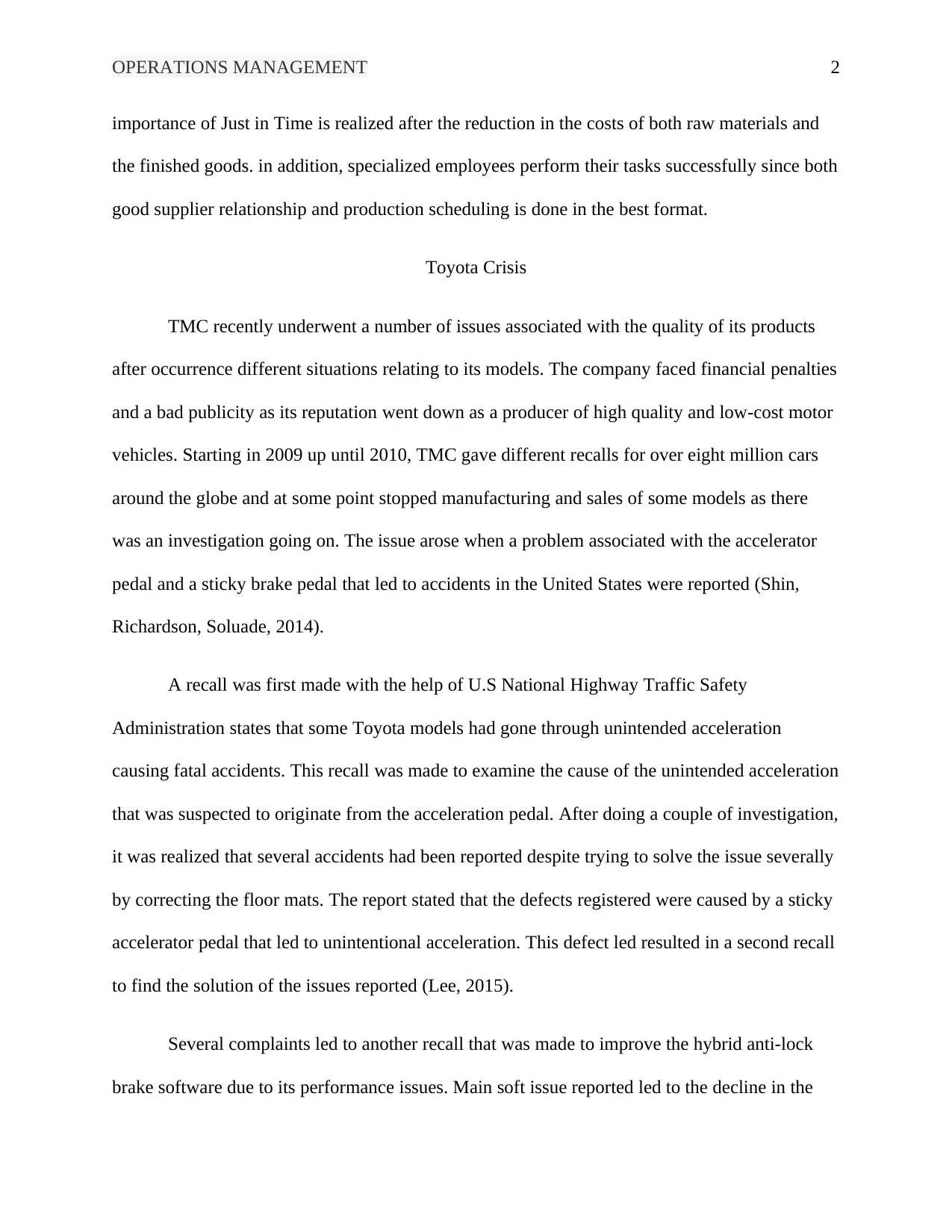
OPERATIONS MANAGEMENT 2
importance of Just in Time is realized after the reduction in the costs of both raw materials and
the finished goods. in addition, specialized employees perform their tasks successfully since both
good supplier relationship and production scheduling is done in the best format.
Toyota Crisis
TMC recently underwent a number of issues associated with the quality of its products
after occurrence different situations relating to its models. The company faced financial penalties
and a bad publicity as its reputation went down as a producer of high quality and low-cost motor
vehicles. Starting in 2009 up until 2010, TMC gave different recalls for over eight million cars
around the globe and at some point stopped manufacturing and sales of some models as there
was an investigation going on. The issue arose when a problem associated with the accelerator
pedal and a sticky brake pedal that led to accidents in the United States were reported (Shin,
Richardson, Soluade, 2014).
A recall was first made with the help of U.S National Highway Traffic Safety
Administration states that some Toyota models had gone through unintended acceleration
causing fatal accidents. This recall was made to examine the cause of the unintended acceleration
that was suspected to originate from the acceleration pedal. After doing a couple of investigation,
it was realized that several accidents had been reported despite trying to solve the issue severally
by correcting the floor mats. The report stated that the defects registered were caused by a sticky
accelerator pedal that led to unintentional acceleration. This defect led resulted in a second recall
to find the solution of the issues reported (Lee, 2015).
Several complaints led to another recall that was made to improve the hybrid anti-lock
brake software due to its performance issues. Main soft issue reported led to the decline in the
importance of Just in Time is realized after the reduction in the costs of both raw materials and
the finished goods. in addition, specialized employees perform their tasks successfully since both
good supplier relationship and production scheduling is done in the best format.
Toyota Crisis
TMC recently underwent a number of issues associated with the quality of its products
after occurrence different situations relating to its models. The company faced financial penalties
and a bad publicity as its reputation went down as a producer of high quality and low-cost motor
vehicles. Starting in 2009 up until 2010, TMC gave different recalls for over eight million cars
around the globe and at some point stopped manufacturing and sales of some models as there
was an investigation going on. The issue arose when a problem associated with the accelerator
pedal and a sticky brake pedal that led to accidents in the United States were reported (Shin,
Richardson, Soluade, 2014).
A recall was first made with the help of U.S National Highway Traffic Safety
Administration states that some Toyota models had gone through unintended acceleration
causing fatal accidents. This recall was made to examine the cause of the unintended acceleration
that was suspected to originate from the acceleration pedal. After doing a couple of investigation,
it was realized that several accidents had been reported despite trying to solve the issue severally
by correcting the floor mats. The report stated that the defects registered were caused by a sticky
accelerator pedal that led to unintentional acceleration. This defect led resulted in a second recall
to find the solution of the issues reported (Lee, 2015).
Several complaints led to another recall that was made to improve the hybrid anti-lock
brake software due to its performance issues. Main soft issue reported led to the decline in the
⊘ This is a preview!⊘
Do you want full access?
Subscribe today to unlock all pages.

Trusted by 1+ million students worldwide
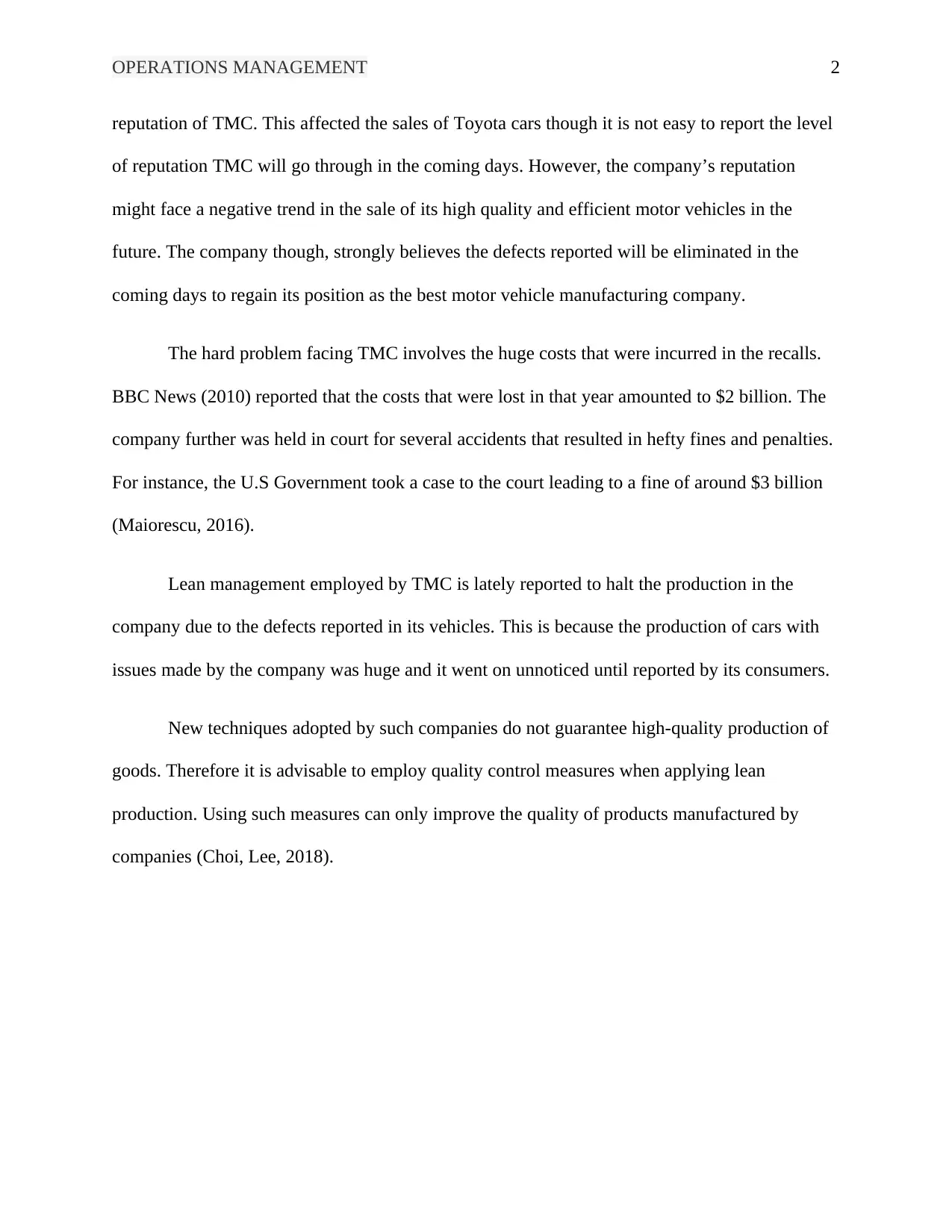
OPERATIONS MANAGEMENT 2
reputation of TMC. This affected the sales of Toyota cars though it is not easy to report the level
of reputation TMC will go through in the coming days. However, the company’s reputation
might face a negative trend in the sale of its high quality and efficient motor vehicles in the
future. The company though, strongly believes the defects reported will be eliminated in the
coming days to regain its position as the best motor vehicle manufacturing company.
The hard problem facing TMC involves the huge costs that were incurred in the recalls.
BBC News (2010) reported that the costs that were lost in that year amounted to $2 billion. The
company further was held in court for several accidents that resulted in hefty fines and penalties.
For instance, the U.S Government took a case to the court leading to a fine of around $3 billion
(Maiorescu, 2016).
Lean management employed by TMC is lately reported to halt the production in the
company due to the defects reported in its vehicles. This is because the production of cars with
issues made by the company was huge and it went on unnoticed until reported by its consumers.
New techniques adopted by such companies do not guarantee high-quality production of
goods. Therefore it is advisable to employ quality control measures when applying lean
production. Using such measures can only improve the quality of products manufactured by
companies (Choi, Lee, 2018).
reputation of TMC. This affected the sales of Toyota cars though it is not easy to report the level
of reputation TMC will go through in the coming days. However, the company’s reputation
might face a negative trend in the sale of its high quality and efficient motor vehicles in the
future. The company though, strongly believes the defects reported will be eliminated in the
coming days to regain its position as the best motor vehicle manufacturing company.
The hard problem facing TMC involves the huge costs that were incurred in the recalls.
BBC News (2010) reported that the costs that were lost in that year amounted to $2 billion. The
company further was held in court for several accidents that resulted in hefty fines and penalties.
For instance, the U.S Government took a case to the court leading to a fine of around $3 billion
(Maiorescu, 2016).
Lean management employed by TMC is lately reported to halt the production in the
company due to the defects reported in its vehicles. This is because the production of cars with
issues made by the company was huge and it went on unnoticed until reported by its consumers.
New techniques adopted by such companies do not guarantee high-quality production of
goods. Therefore it is advisable to employ quality control measures when applying lean
production. Using such measures can only improve the quality of products manufactured by
companies (Choi, Lee, 2018).
Paraphrase This Document
Need a fresh take? Get an instant paraphrase of this document with our AI Paraphraser
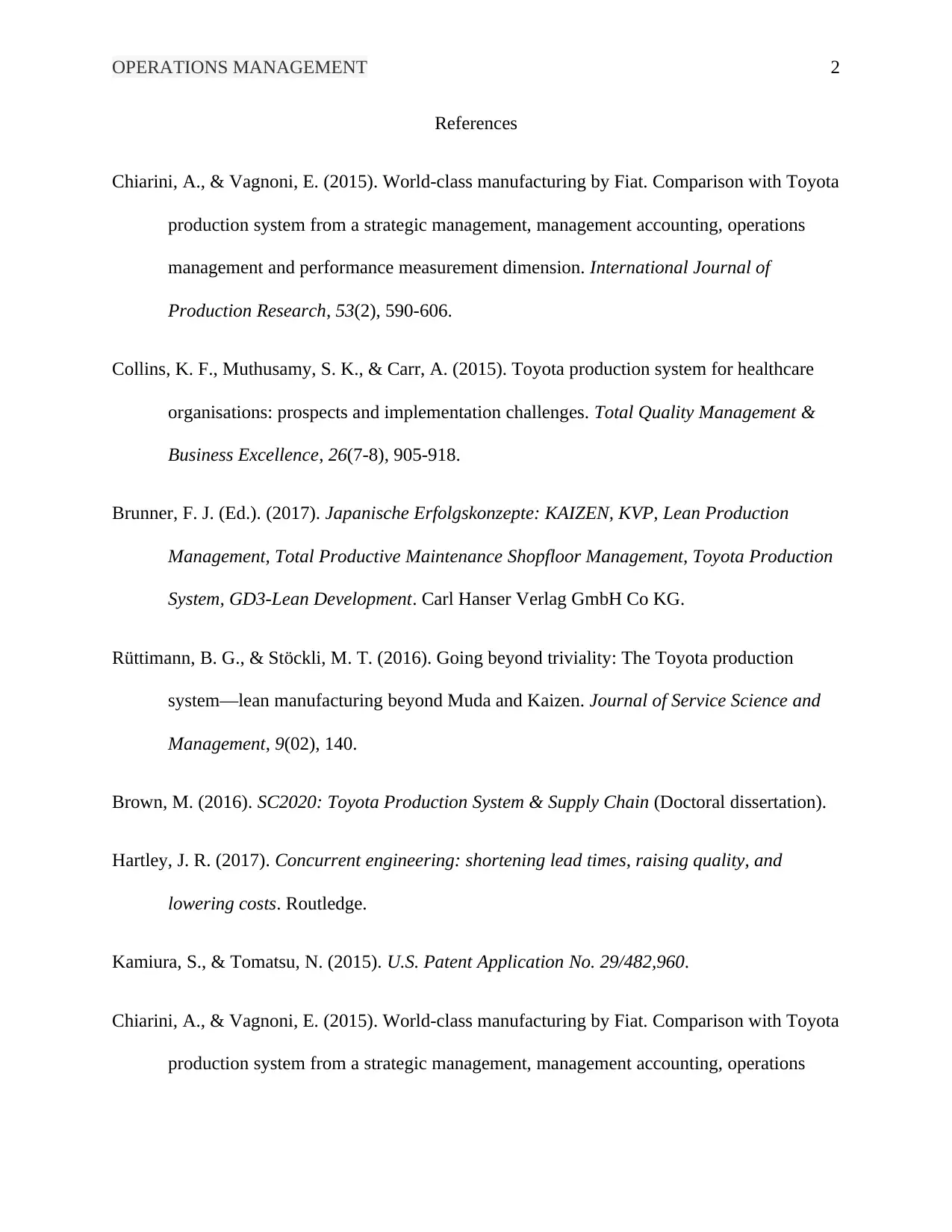
OPERATIONS MANAGEMENT 2
References
Chiarini, A., & Vagnoni, E. (2015). World-class manufacturing by Fiat. Comparison with Toyota
production system from a strategic management, management accounting, operations
management and performance measurement dimension. International Journal of
Production Research, 53(2), 590-606.
Collins, K. F., Muthusamy, S. K., & Carr, A. (2015). Toyota production system for healthcare
organisations: prospects and implementation challenges. Total Quality Management &
Business Excellence, 26(7-8), 905-918.
Brunner, F. J. (Ed.). (2017). Japanische Erfolgskonzepte: KAIZEN, KVP, Lean Production
Management, Total Productive Maintenance Shopfloor Management, Toyota Production
System, GD3-Lean Development. Carl Hanser Verlag GmbH Co KG.
Rüttimann, B. G., & Stöckli, M. T. (2016). Going beyond triviality: The Toyota production
system—lean manufacturing beyond Muda and Kaizen. Journal of Service Science and
Management, 9(02), 140.
Brown, M. (2016). SC2020: Toyota Production System & Supply Chain (Doctoral dissertation).
Hartley, J. R. (2017). Concurrent engineering: shortening lead times, raising quality, and
lowering costs. Routledge.
Kamiura, S., & Tomatsu, N. (2015). U.S. Patent Application No. 29/482,960.
Chiarini, A., & Vagnoni, E. (2015). World-class manufacturing by Fiat. Comparison with Toyota
production system from a strategic management, management accounting, operations
References
Chiarini, A., & Vagnoni, E. (2015). World-class manufacturing by Fiat. Comparison with Toyota
production system from a strategic management, management accounting, operations
management and performance measurement dimension. International Journal of
Production Research, 53(2), 590-606.
Collins, K. F., Muthusamy, S. K., & Carr, A. (2015). Toyota production system for healthcare
organisations: prospects and implementation challenges. Total Quality Management &
Business Excellence, 26(7-8), 905-918.
Brunner, F. J. (Ed.). (2017). Japanische Erfolgskonzepte: KAIZEN, KVP, Lean Production
Management, Total Productive Maintenance Shopfloor Management, Toyota Production
System, GD3-Lean Development. Carl Hanser Verlag GmbH Co KG.
Rüttimann, B. G., & Stöckli, M. T. (2016). Going beyond triviality: The Toyota production
system—lean manufacturing beyond Muda and Kaizen. Journal of Service Science and
Management, 9(02), 140.
Brown, M. (2016). SC2020: Toyota Production System & Supply Chain (Doctoral dissertation).
Hartley, J. R. (2017). Concurrent engineering: shortening lead times, raising quality, and
lowering costs. Routledge.
Kamiura, S., & Tomatsu, N. (2015). U.S. Patent Application No. 29/482,960.
Chiarini, A., & Vagnoni, E. (2015). World-class manufacturing by Fiat. Comparison with Toyota
production system from a strategic management, management accounting, operations
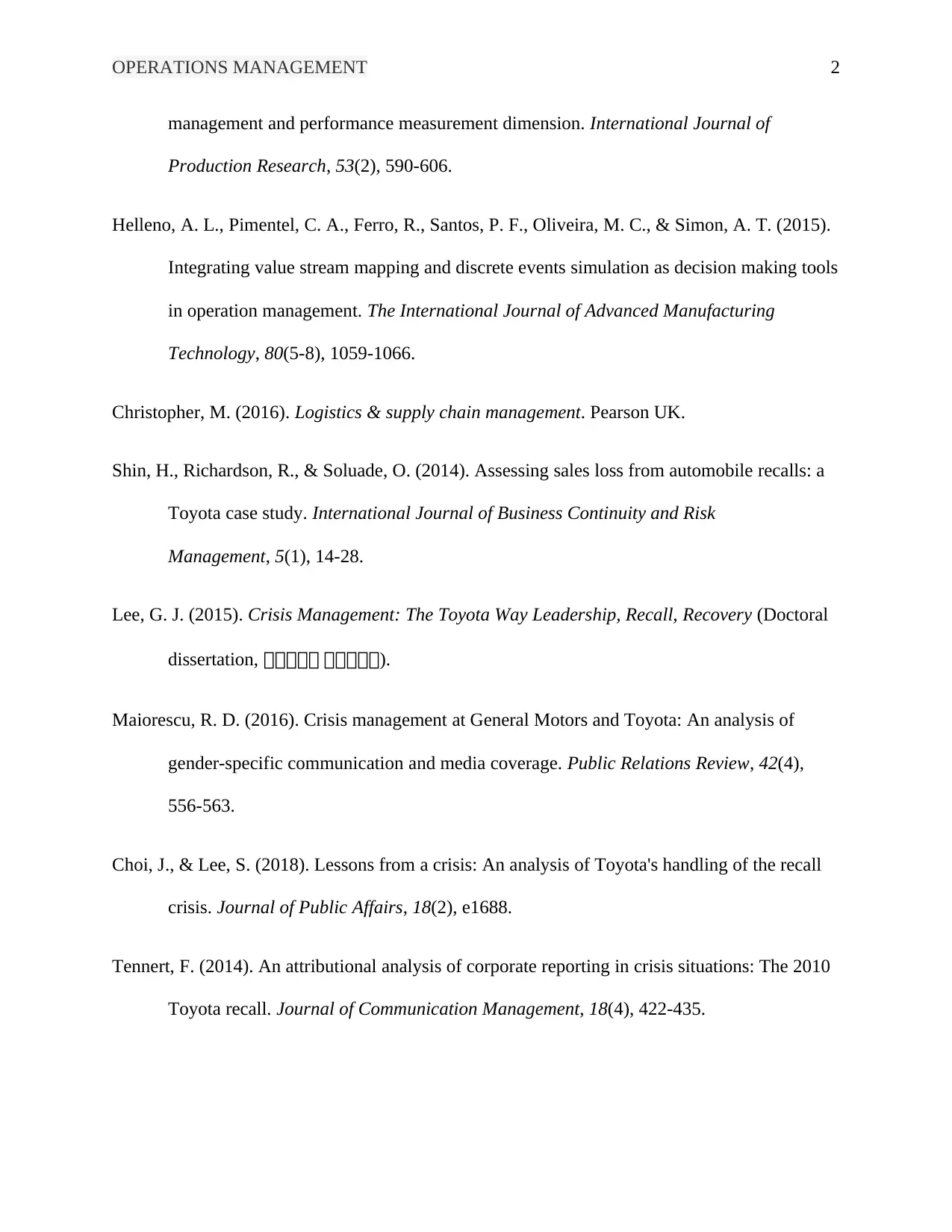
OPERATIONS MANAGEMENT 2
management and performance measurement dimension. International Journal of
Production Research, 53(2), 590-606.
Helleno, A. L., Pimentel, C. A., Ferro, R., Santos, P. F., Oliveira, M. C., & Simon, A. T. (2015).
Integrating value stream mapping and discrete events simulation as decision making tools
in operation management. The International Journal of Advanced Manufacturing
Technology, 80(5-8), 1059-1066.
Christopher, M. (2016). Logistics & supply chain management. Pearson UK.
Shin, H., Richardson, R., & Soluade, O. (2014). Assessing sales loss from automobile recalls: a
Toyota case study. International Journal of Business Continuity and Risk
Management, 5(1), 14-28.
Lee, G. J. (2015). Crisis Management: The Toyota Way Leadership, Recall, Recovery (Doctoral
dissertation, 서서서서서 서서서서서).
Maiorescu, R. D. (2016). Crisis management at General Motors and Toyota: An analysis of
gender-specific communication and media coverage. Public Relations Review, 42(4),
556-563.
Choi, J., & Lee, S. (2018). Lessons from a crisis: An analysis of Toyota's handling of the recall
crisis. Journal of Public Affairs, 18(2), e1688.
Tennert, F. (2014). An attributional analysis of corporate reporting in crisis situations: The 2010
Toyota recall. Journal of Communication Management, 18(4), 422-435.
management and performance measurement dimension. International Journal of
Production Research, 53(2), 590-606.
Helleno, A. L., Pimentel, C. A., Ferro, R., Santos, P. F., Oliveira, M. C., & Simon, A. T. (2015).
Integrating value stream mapping and discrete events simulation as decision making tools
in operation management. The International Journal of Advanced Manufacturing
Technology, 80(5-8), 1059-1066.
Christopher, M. (2016). Logistics & supply chain management. Pearson UK.
Shin, H., Richardson, R., & Soluade, O. (2014). Assessing sales loss from automobile recalls: a
Toyota case study. International Journal of Business Continuity and Risk
Management, 5(1), 14-28.
Lee, G. J. (2015). Crisis Management: The Toyota Way Leadership, Recall, Recovery (Doctoral
dissertation, 서서서서서 서서서서서).
Maiorescu, R. D. (2016). Crisis management at General Motors and Toyota: An analysis of
gender-specific communication and media coverage. Public Relations Review, 42(4),
556-563.
Choi, J., & Lee, S. (2018). Lessons from a crisis: An analysis of Toyota's handling of the recall
crisis. Journal of Public Affairs, 18(2), e1688.
Tennert, F. (2014). An attributional analysis of corporate reporting in crisis situations: The 2010
Toyota recall. Journal of Communication Management, 18(4), 422-435.
⊘ This is a preview!⊘
Do you want full access?
Subscribe today to unlock all pages.

Trusted by 1+ million students worldwide
1 out of 13
Related Documents
Your All-in-One AI-Powered Toolkit for Academic Success.
+13062052269
info@desklib.com
Available 24*7 on WhatsApp / Email
![[object Object]](/_next/static/media/star-bottom.7253800d.svg)
Unlock your academic potential
Copyright © 2020–2025 A2Z Services. All Rights Reserved. Developed and managed by ZUCOL.





